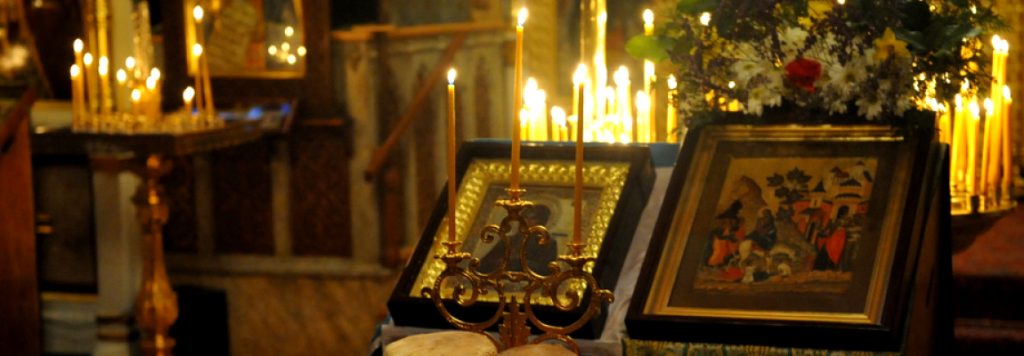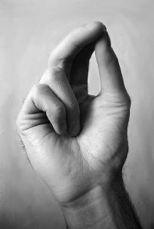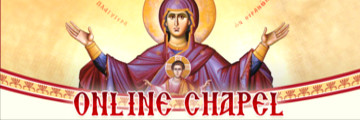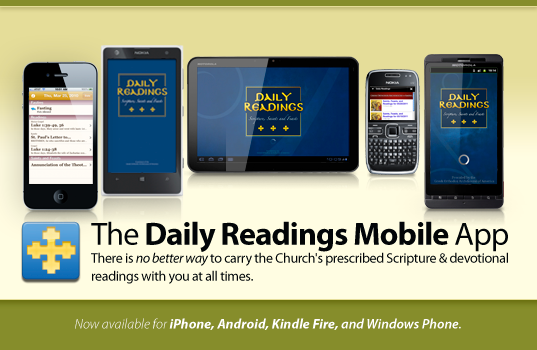
We enter the Temple to unite together in worship, opening our hearts to Christ in all things. The form and nature of Church etiquette arises from this purpose and supports it. General instructions include:
Dress Code
What we wear should not draw attention to ourselves, but reflect modesty, humility and love. Generally speaking, for men this means wearing clean dress pants and a collared, button-up shirt or sweater. Women should avoid tight clothing, low-cut and sleeveless tops, open backs and shorter-than-knee-length skirts or dresses. If pants are preferred, do not wear denim, sweatpants, body stockings or shorts. Covering the head is not required, but is a traditional way of expressing humility before God.
How to Enter an Orthodox Church
The Temple is a holy place. Upon entering the house of God, we make the sign of the cross and reverence the icons in the Narthex. In Holy Transfiguration Church, Christ is on the right side and the Holy Theotokos on the left in the Narthex and the icon for the feast of the day is to the right of Christ. We may then light a candle for those we pray for.
You should arrive before the services begin in order to do this. In the early church, it was considered to be great disrespect to God and laxity to be late. If this occurred, persons would not receive Holy Communion that day. When we arrive late, we may distract others and send the unconscious message to our children, families, and friends, that worship isn’t as important as work or school or sports events for which we are always on time. Why should we show up late to worship God?
If you do happen to be late, if the priest is standing in front of the Holy Doors in the center of the church, you should wait until he goes back into the altar before finding a seat. If the priest is censing, wait until he is finished before approaching the iconostasis to light a candle or reverence the icons.
How to Cross Yourself.
Orthodox Christians express two foundational revelations of Christian faith by making the sign of the cross during worship and in a specific way.

Joining the thumb, index, and middle fingertips of your right hand together [signifying the Holy Trinity: Father, Son and Holy Spirit], while closing the other two fingers against the palm [signifying the two natures of Christ, uncreated divinity and created humanity in one Person] touch the joined fingertips to your forehead.
Then sweep down to the abdomen; move to right shoulder crossing over to the left shoulder. Some then cover the heart with their hand. This movement is understood as signifying the Incarnation from the Father to the Son and the Holy Spirit bringing Christ to the heart.
There are no strict rules about when to cross yourself. It is appropriate at the mention of the Holy Trinity during worship; for the Holy Theotokos, the Cross and before reverencing icons. The sign of the Cross is made at any time one offers up prayer to God; before and after eating; when passing in front of the Holy Table and when entering and leaving the Church, facing the Altar.
When the priest makes the sign of the cross as a blessing or censes you during the service [which is also a blessing], you do not make the sign of the cross. The proper response is to bow the head slightly and you may put a hand over the heart, to acknolwedge the blessing.
Veneration of Icons
When venerating icons and relics in the Church, cross yourself twice, kiss the icon and/or incline your head toward it, and then cross yourself a third time.
- Kiss the hands or feet of those represented in the icons, not the face
- You may also kiss the Gospel book, scroll or cross held in the hand of the saint, if they are depicted in the icon
- Do not venerate icons while wearing lipstick or lip balm – this can damage them.
How to Greet an Orthodox Priest
Traditionally, laity greet priests either by cupping their hands for a blessing and/or by kissing the back of the priest’s right hand. This is a request for a blessing from Christ and reverence for Christ offered through the priestly office. It is humbling for the priest who stands between the person requesting a blessing and Christ who offers it through him.
Welcoming Children in Worship
Children are welcome in the services, even when visiting for the first time. If you bring little ones with you, guide them and help them understand proper behavior in church. If you love the church, your children will come to know this and respond to this rather than attempts to control them which they may resist or simply conform too without developing a genuine love and presence.
- Do not let your child wander about in the worship. If your child cries or makes excessive noise, please remove them until they calm down. You may attend the service virtually in the fellowship hall if you need too.
- Do not to bring snacks for children older than 3 years. Fasting in preparation for Holy Communion can begin early if you take care to help the children understand. Of course if there are medical issues or other concerns, talk with the priest about it.
- If you bring toys, bring ones that don’t make noise. Rather than teach children to play in church, talk softly to them. Walk around with them to reverence the icons, light candles and by prayers at home, and your quiet attention, gradually help them grow to love the Church and prayers.
Holy Communion
In the Orthodox Church only baptized and chrismated Orthodox Christians receive Holy Communion during services. Why? Because the Church is Christ’s own Body (1 Cor. 12:27), His Bride (Rev. 21:9), the Israel of God (Gal. 6:16), and the Vine to which individual members are grafted in (Rom. 11:17). The Lord set an example for us by distributing the Last Supper to His disciples alone. Only when you are united with the Orthodox Church and become a member of the Body can you partake of the Body and Blood of the Lord.
If you are already an Orthodox Christian and you have prepared yourself to receive Holy Communion according to your Spiritual Father’s direction, be sure to introduce yourself to our priest before the service. You are welcome then to approach the chalice.
All who are not Orthodox are welcome to partake of the blessed bread antidoron handed out by the priest following the Divine Liturgy.
Exiting the Church
The Holy Altar contains the Tabernacle within which is the reserve Sacrament of the Body and Blood of Christ. Therefore whenever we pass in front of the Altar we make the sign of the cross. It is customary when exiting the Temple, to turn at the door, face the Altar and make the sign of the cross.



